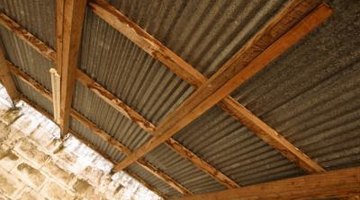What Kind of Roof Sealer Do I Need to Seal Nail Holes on a Tin Roof?
Before the introduction of reliable roofing screws, metal roofs were attached with nails. Because metal expands and contracts with changes in temperature, over time nails start to work out of their holes, and their holes begin to get larger. The best way to update a tin roof is to replace all of these nails with screws that have rubber gaskets on them. The screws will hold the metal down effectively, but you still need to fix all the holes from the nails.
Gaskets

Old metal roofing nails were equipped with lead gaskets that would be compressed when the nail was driven in, thereby keeping water out. Newer nails and roofing screws are fitted with rubber gaskets, which work better and don't present the health and environmental threats of lead. If you are replacing a nail and the hole that it's in hasn't expanded, you can put a screw with a rubber gasket through the same hole to prevent leaking. If the hole has increased in size and is larger than the gasket, you should put the screw into a new hole and completely seal the old nail hole.
Tar
Roofing tar is one of the best materials for sealing old nail holes on a tin roof. It's durable, easy to apply, and flexible so it will remain waterproof for many years while the tin roof expands and contracts through winter and summer. You can buy roofing tar in tubes that fit into a caulking gun for easy application. Place the tip of the tar tube into the hole and squeeze a bit of tar in so it's underneath the tar as well as above it and then squeeze a bit more tar on the surface of the tin roof. Flatten it out with a putty knife and leave it to dry.
Paint
You can prevent your tin roofing from deteriorating further by painting it. Painting after filling all the holes with roofing tar will also make it look better, since without the paint it will be covered with black spots. Clean the tin surface of all dirt, grit, moss, and as much rust as you can. Cover the roof with a high-quality, exterior, oil-based primer. Let the primer dry for a day or two and then paint the roofing with an oil-based metal paint that is designed for heavy weather exposure.
Patches
Nail holes that have been torn and other large damaged areas will need to be patched, since they are too large for roofing tar. If possible, use the same kind of roofing already on the roof. Cut a piece that is several inches larger than the hole. Work the patch into the hole so that it is underneath the original roofing on the uphill side but overlapping the roofing that is below it. Screw the patch down with roofing screws that have rubber gaskets and then seal all of the joints with roofing tar.
References
Writer Bio
Jagg Xaxx has been writing since 1983. His primary areas of writing include surrealism, Buddhist iconography and environmental issues. Xaxx worked as a cabinetmaker for 12 years, as well as building and renovating several houses. Xaxx holds a Doctor of Philosophy in art history from the University of Manchester in the U.K.
Photo Credits
- Jupiterimages/Photos.com/Getty Images
More Articles



